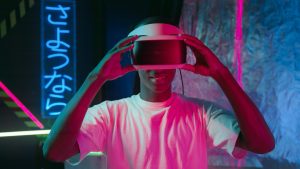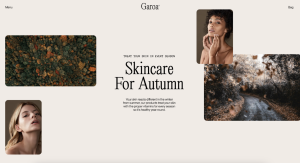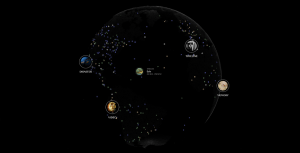In an era where capturing the attention of users is vital, how do we effectively tell stories about companies, brands, or newly launched features while utilizing technological advancement? This article talks about a shift in effective storytelling in the digital world and gives a glimpse into how it can be implemented.
The digital storytelling landscape is undergoing a transformation, moving away from traditional linear narratives to immersive experiences that significantly enhance audience engagement. One of the most recent examples being the Spotify Wrapped, which was incorporated by many brands to their yearly recap content and digital campaigns in the end of 2023.
Whether for cinematic VR experiences, branding, or marketing, immersive storytelling leverages the latest technologies to foster a unique sense of presence in alternate environments. With a significant perceived decrease in the users attention span, as found by King’s College London professors, creating digital content, whether it is illustrations, videos or other forms of depicting a story, in more captivating formats.
Technologies empowering immersive storytelling
The integration of cutting-edge technologies like Virtual Reality (VR), Augmented Reality (AR), and Artificial Intelligence (AI) have revolutionized immersive storytelling. These technologies enable new ways to engage with narratives, creating experiences that were once difficult or impossible. Let’s delve into how each technology contributes to immersive storytelling.
 Photo by Artem Podrez
Photo by Artem Podrez
VR immerses users in the narrative world, offering a 360-degree experience that places them at the heart of the story. This immersive quality allows users to interact directly with the environment and characters, ranging from moving objects to choosing narrative paths, therefore personalizing the storytelling experience. The sensation of being “inside” the story intensifies emotional connections, empathy for characters, and engagement with the story’s outcomes.
AR overlays digital information onto the real world, which can be used to add layers of story to everyday environments. This can transform a simple location into a stage for narrative events, with users’ surroundings becoming an integral part of the story. Similar to VR, AR enables users to interact with the story in a tangible way. AR’s blend of digital and real-world elements facilitates unique interactive experiences, like solving physical puzzles that affect the story. Its accessibility via smartphones and tablets broadens audience engagement, opening up new possibilities for storytelling in education and design.
AI offers dynamic story adaptation by responding to user choices or actions in real time, creating a deeply personalized storytelling experience. This includes modifying dialogue, story outcomes, or environments to suit user interactions. AI-powered characters can interact with users in a more natural way, thanks to advances in natural language processing, making the narrative more authentic. AI also supports content creation within stories, generating customized text, images, or music, ensuring each user’s experience is unique and tailored to their journey through the story.
Enhancing Engagement with Immersive Storytelling Elements
Scroll-based animation
Scroll animations provide many advantages, such as emphasizing key areas, acting as confirmation for user actions, introducing micro-interactions, triggering positive emotional responses, and enhancing the narratives on the website. Scroll based animations can also help carve out a distinct brand identity, elevating the overall accessibility and enjoyment of a site or application. However, the effective use of animations requires understanding their nuances and how they interact with different user actions like hovering, clicking, and scrolling. The diverse benefits and applications of scroll animations underscore their popularity in web design, showcasing their role in creating visually appealing and user-friendly websites.
Video from the Persepolis Reimagined website
Rich Media
With the increase of device and browsing power, the web content includes high-resolution media which is implemented through images and videos. Digital stories typically use rich media to make a powerful impact and initiate the commonly known shock effect, making the stories more captivating. This technique is more commonly used in marketing space, which can often be seen in social inequality, environment or abuse prevention commercials. The rich media can be seen in the use of transitions, media embeds as well as different effects such as glitching, that are often influenced by digital trends.

UN Women ad series reveals widespread sexism
Responsiveness and intuitive actions
Known as a good practice in UX and UI, incorporating responsive design and intuitive actions is one of the key elements in creating a great story. When developing a Virtual Reality experience, interactivity must be thoughtfully designed to offer logical actions, enhancing user immersion within the narrative.
When the story is told through digital devices like a smartphone or computer, the story has to be responsive on all devices. If the story is responsive on desktop but not on smartphone, the designer is creating an unresponsive solution that likely will create more dissatisfaction than curiosity to engage in the content, refraining from increasing the user retention and satisfaction.
Font and layout optimization
Another element that helps increase the usability of a website/app and the attention span of the users is to make use of unique fonts that vary in different text parts. The fonts help to break up the layout of the content, making it easier for the user to focus on new pieces of information. Creating a layout that provides a different information structure can help to maintain the interest of the reader to continue interacting further. Garoa exemplifies a use of fascinating typography that captures the attention while incorporating moving elements and images that convey the message along with the text.

From Garoa website
Immersive Storytelling in Action: Digital Design Examples
Here you can see 3 immersive stories. The first example is from a VR experience based exhibition that was screened in 2023 at the Museum of Moving Image in New York City. On the Morning You Wake leverages groundbreaking documentary storytelling and virtual production methods to convey the real-life experiences of individuals who, during a span of 38 minutes, faced the daunting challenge of making critical decisions amidst the threat of nuclear violence. The story takes advantage of various storytelling techniques and merges with the VR technology. You can have a look at the trailer of the documentary story here.
 Snapshot from the On the Morning You Wake (To the End of the World)
Snapshot from the On the Morning You Wake (To the End of the World)
In 2019, Stuart A. Thompson and Charlie Warzel published an opinion article in the The New York Times called: “Twelve Million Phones, One Dataset, Zero Privacy.” The article quickly became known as One Nation, Tracked – The Privacy Project. The article focuses on diving deeper into the smartphone tracking and personal privacy in the United States, right at the critical era of reviewing privacy laws in Europe and the US. On the website you can see the data visualization of over 50 billion location pings from more than 12 million Americans’ phones during 2016 and 2017, tracking user movements in major cities. This form of immersive visualization has a significant impact on the perception of the importance of the issue and therefore proves to be a powerful tool for storytelling in digital space.
 From the article “Twelve Million Phones, One Dataset, Zero Privacy” by The New York Times
From the article “Twelve Million Phones, One Dataset, Zero Privacy” by The New York Times
What is Missing website that serves as an educational hub, shedding light on the Earth’s sixth mass extinction, encompassing the loss of species, habitats, and more. In 2023, the solution was a Activism Webby Award Winner. Upon entry to the website, a captivating rendition of our planet, crafted from dots, greets the user. Within this virtual landscape, you can find a wide selection of categories to explore, each offering profound insights into the various facets of the natural world that have fallen victim to human activities. Throughout this immersive journey, the soundscapes featuring the calls of vanishing wildlife and the whispers of the wind serve as a mournful accompaniment to the unfolding narrative. This website stands as a powerful example of digital storytelling in raising awareness and fostering appreciation for the delicate beauty of the Earth.
 From What is Missing? website
From What is Missing? website
Sources
https://www.kcl.ac.uk/news/are-attention-spans-really-collapsing-data-shows-uk-public-are-worried-but-also-see-benefits-from-technology
https://www.onthemorningyouwake.com
https://www.nytimes.com/interactive/2019/12/19/opinion/location-tracking-cell-phone.html
https://www.halo-lab.com/blog/scroll-animations-for-your-website
https://www.whatismissing.org/
https://persepolis.getty.edu/
***










